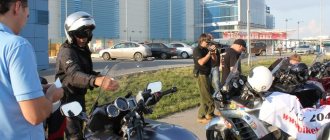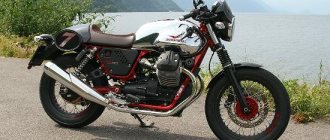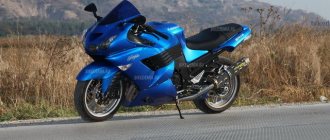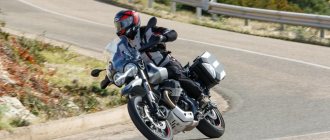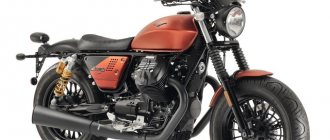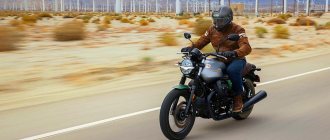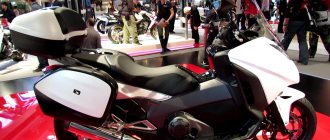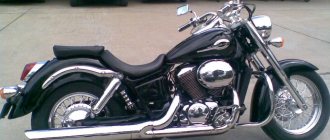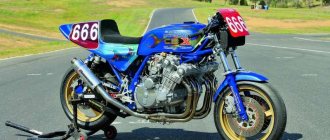Moto Guzzi California
Stefano says that everything happened quite interesting. Andy Chase (a musician and producer from New York) came to him and literally fell in love with the Diabola V35C. We were impressed with Moto Guzzi's new 1380cc engine, much more so than the California 1400 Touring bike it was built for. Stefano and Andy immediately found a lot of common ground, and they decided to join forces and remake the motorcycle after all.
Moto Guzzi California
California 1400 Touring. What kind of animal?
Friends, I present to your attention a short essay about my impressions of the operation of a motorcycle of Italian blood, still rare on the roads of Russia, from the Moto Guzzi company of the Piaggio concern.
In May of this year, the first cruiser in my motorcycle experience, the California 1400 Touring, appeared in my stable.
Why not Harley? Well, if only because when you tell someone that you took a chopper (not in the exact, but in the broad philistine sense of this type of motorcycle), then in response you hear a predictable question: “Harley?” Individuality is somehow more attractive to me than cultism, but clubbing and external special effects around a brand that is patriotic for Americans just don’t excite me. In general, the choice fell on the Italian, especially since the now disgraced Berlusconi is still a friend of our president, and Obama, lately, has been an outright bad guy. ))
I’ll make a reservation right away that I will talk specifically about my impressions, i.e. about the impressions of a person who first sat on a motorcycle of this class. I have nothing to compare it with; the first number in the stable is the ascetic, evil roadster BMW R1200R.
The California 1400 model was released at the autumn exhibition in Milan in 2012, and the following year this motorcycle was recognized as the best cruiser of the year according to the authoritative American magazine Robb Report robbreport.com/paid-issue/best-best-2013-motorcycles-cruiser- moto-guzzi-california-1400-custom That same year, I saw it for the first time at the February exhibition in Helsinki, and immediately fell in love with the amazing harmony of its external gloss and an almost tangible feeling of internal technical perfection and strength. In general, the Italian style cannot be confused with anything, and the author of the California design was Miguel Galuzzi, known for his work on the Ducati Monster motorcycle. In his words, “The California 1400 is a balance between tradition and the future, and the motorcycle itself, hand-assembled at the Mandello del Lario factory, is imbued with an aura of quality.” And it is not just words. Even the paint marks on the threaded connections emphasize its uniqueness, as opposed to the now familiar conveyor belt.
I planned the purchase of this motorcycle for a trip to Crimea, a report about which is on the portal: , and my impressions of the motorcycle were formed precisely on that trip.
The Touring modification cost me about 22,000 Euros. In neighboring Finka it costs 25,000, so I think that the price turned out to be humane. There is no official representative office of Moto Guzzi in Russia, but there are those who sell Italian motorcycles; they transport both motorcycles and spare parts through Riga. By the way, both spare parts and a tuning body kit for Italian motorcycles can be obtained much faster from America from the site www.af1racing.com/store/Scripts/default.asp, but delivery from them is not cheap - about $90. So, if you buy something there, then it is advisable to create an order with a total value of under $1000, then the delivery price will be dissolved in it.
The power unit of this moto is a 1380 cc TRANSVERSE V-twin with air-oil cooling, producing 95 hp. at 6500 rpm and 120 Nm at 2750 rpm. This is the largest V-shaped “two” currently produced in Europe. It works in tandem with a six-speed gearbox.
Tractor traction at the bottom. Smart electronics offers three options for its use - modes: “Speed”, “Tourism” and “Rain”. In the “Speed” mode, the engine shoots forward 330 kg of stainless steel, chrome and my 75 kg+ easily and without strain. Also, it allows you to easily and happily snack at intersections with spurred boxes, leaving their owners in slight bewilderment. I traveled to Crimea in the “Tourism” mode. It assumes a less acute engine response to opening the gas, and, accordingly, fuel economy on the highway. The “Rain” mode makes the bike frankly sluggish, I tried it, but did not use it in practice. These modes can be switched both when parked and while driving. Also, the basic equipment includes three-level traction control that eliminates slipping. At least once, he saved me from falling in a turn on the slightly sandy asphalt. By the way, there is also cruise control, which I didn’t even check..)
My height is 173 cm. California's saddle height is 740 mm. To make my soles touch the ground more comfortably, I wanted to sit lower, although my BMW roadster has a height of 760mm. I ordered a 720mm seat, but haven’t received it yet. The placement of the footrests is ideal for me. With my height, my legs are bent at the knees at an angle of slightly more than 90 degrees, and this position not only does not tire them in a long distance, but also allows me to stand up, resting on the platforms when I find myself on a hummock. In general, according to my feelings, the suspension seemed quite stiff, and every bump in the road tried to make itself felt. The shock absorbers can be adjusted, but I haven’t bothered with this yet, but I found a technique that allows me to compensate for the impact of bumps. The shape of the California seat has a pronounced rise and rib where the pilot's seat meets the passenger's seat. When flying onto a broken section of the road, it is enough for me to stand up, resting my feet on the platforms, and my fifth point against the rib of the seat, and nothing is felt in the spine. The footrests are naturally cushioned with rubber inserts. I don’t quite understand what happens in such situations with the carcasses of the choperast brothers who ride those motos where the heels point forward. )
The transverse orientation of the engine cylinders creates an additional thermal field for the knees. This was not too noticeable for my legs even in the heat, but once, while talking with a Dutchman of a grenadier build and on long stilts, I heard that for this reason he could not ride in California - his knees were burning. The clutch and brake levers are adjustable in five positions. For my hands, I found them too protruding and long, even in the extreme adjustment position, and changed them to more accurate tuning ones. Radial brakes and Brembo calipers, according to reviews from those who have ridden heavy cruisers, work very well, but for me, who have not encountered motorcycles that do not brake, they are just fine. The integral ABS system, which acts on both wheels when you press any of the brakes, also copes with the task honestly. The weight of the motorcycle in motion at any speed is not felt; it steers surprisingly easily and predictably. You can, without straining, make turns, scraping the footpegs, and move at a walking speed, but in the parking lot I quickly learned to be very careful not to put the bike in a hole, or on a slope towards an obstacle. Pushing him back up the hill with your feet is a thankless task, and in some situations, impossible alone. In general, driving it alone from asphalt to sand or onto goat paths is an unjustified gamble.
The average fuel consumption according to the on-board computer for the entire trip (5600 km) was 6.7 l/100 km. Tank capacity - 20 liters is not enough for the highway, but not critical. Making stops for gas after 250 km is even correct from the point of view of forcing yourself to rest. On the highway I maintained a speed of 140-160 km/h. If you don’t push it above 120 km/h, then the consumption, I think, would be about 6 liters per hundred square meters. The digital fuel level indicator in the tank does not work proportionally. I noticed that after a full refueling, the top bar of the indicator disappears after one hundred kilometers, the next after sixty, the next after forty, in general, the relationship is not linear. When the level reaches a certain critical level, the computer lets you know about it and switches to the mode of counting kilometers from this moment. Experimentally, I found out that the remaining “reserve” fuel is enough for 55 - 70 km, depending on the speed. By the way, the speedometer also lies, and the higher the speed, the more it lies. I checked it using GPS – 157 km/h on the speedometer, that’s a fair 150 km/h.
The futuristic design of the headlight has two lighting modes - daytime LED and regular night halogen, to which light from fog lights can be added.
The only unpleasant discovery for me in California was a phenomenon close to wobbling. I use the term “close” deliberately because there is no consensus on the true nature of wobbling, but there is much debate. There is no steering damper on the California. In my case, an increase in the amplitude of spontaneous (forced) vibrations of the steering wheel appeared at speeds above 150 km/h, and this was preceded, as a rule, by a calm, stable mode of straight-line movement with a constant speed. I think the main reason for this was the large stock windshield (H57 x W58cm), which caused some aerodynamic resonance. I quickly learned to feel its beginning, and smoothly, slightly releasing the gas and standing up, I extinguished the sausage by transferring my body weight from the seat to the footrests. In classic wobbling, many advisers recommend opening the gas on the contrary, I haven’t tried it. After returning from the trip, I replaced the windshield with a smaller one (H44 x W52cm) and changed the angle of its inclination, placing it more steeply. It doesn’t wobble anymore, and the wind protection is quite enough. In general, when driving at speeds over 140 km/h, the oncoming air flow, of course, is felt, but it is more likely turbulent jets from the headlights, fender and fork, and not the wind tearing off the helmet and forcing the wind to lie on the tank.
The Touring modification comes with 35-liter plastic side cases that follow the lines of the rear fender. During the trip, their volume was quite enough for me. After returning, I removed the side cases and the frames protecting them, which optimized the cross-section of the bike for city riding.
If you go on a long journey with a passenger, then it is reasonable, in addition to the side ones, to buy a rear 50-liter trunk with a frame. It will also serve as a soft passenger backrest. There is also an original 65-liter case, but its price tag is as if it were made entirely of carbon. Also, for the passenger, you can purchase additional footrests similar to the driver’s ones. The factory equipped passenger footrests have a conventional folding design. For the off-season, you can purchase heated grips; all electrical preparation for their installation on the steering wheel is provided.
And, of course, a few words about mufflers. What motorcycle owner doesn’t want to give up the standard and install something wonderful for an additional fee?! ;-P I didn’t like the flared shape of the stock mufflers and the insufficiently expressive timbre of their sound in the mid-speed range and above. Therefore, the standard ones were replaced by the Mistral model.
Neither on a trip nor at home, the moto has never failed, there have been no breakdowns. I don't see any problems with maintenance. Any spare parts and consumables can be ordered, and any competent motor mechanic can adjust the valves and replace fluids/filters. There is a technological manual.
Brief conclusion; I have never regretted purchasing an “exotic” moto. The motorcycle is expressive, technically modern, reliable and functional enough for long-distance driving on asphalt.
Thank you for your attention! ))
In conclusion, the technical specifications of the California 1400 Tourng model are:
Frame type: Tubular steel with an elastic kinematic engine mounting system to isolate vibration Front suspension type: 46 mm hydraulic telescopic fork Front suspension travel, mm: 120 Rear suspension type: Pendulum, two shock absorbers with adjustable preload and rebound Rear suspension travel, mm : 110 Front brakes: Two floating discs with 4-piston Brembo radial calipers Disc diameter, mm: 320 Rear brakes: One disc with 2-piston Brembo floating caliper Disc diameter, mm: 282
Dimensions Length, mm: 2445 Width, mm: 1030 Height, mm: 1460 Seat height: 740 Base, mm: 1685 Trail, mm: 155 Ground clearance, mm: 165 Curb weight, kg: 337 Fuel tank volume, l: 20
Engine Engine type: 4T Cylinder arrangement: V-shaped with transverse arrangement Number of cylinders: 2 Number of valves: 8 Engine volume, cc: 1380 Power, hp at rpm: 95/6500 Maximum torque Nm, at rpm: 120/2750 Piston diameter and stroke, mm: 104 x 81.2 Compression ratio: 10.5: 1 Power system: Multipoint sequential injection Magneti Marelli IAW7SM, throttle body diameter 52 mm, IWP 243 Magneti Marelli injectors, two NGK LMAR8F spark plugs per cylinder Cooling type: Air-oil Fuel type: Gasoline Ignition system: Dual ignition Starting system: Electric
Transmission Clutch: Single-disc, dry with built-in anti-vibration buffer Gearbox: Mechanical Number of gears: 6 Drive: Cardan
Wheels Wheel type: Cast alloy Tires: Front: 130/70R18; Rear: 200/60R16
Safety Anti-lock braking system (ABS) Traction control system: “Speed”, “touring”, “rain” modes Traction control: MGCT, three modes Cruise control #motoguzzicalifornia1400touring #motoguzzi
Honda ST 1100 (ST1100) Pan European technical specifications
What makes a successful vehicle model? Motor? Suspension? Duration of release? No. Even with all the advantages, the model may seem like a failure.
But if the traffic police like it, its success is guaranteed.
This is exactly what the Honda ST 1100 Pan European became. Having appeared in 1990, the police in England and America liked it so much that two years later the developers presented a special model - Honda ST 1100 Police . A different color, a more powerful engine and a different instrument panel distinguished the policeman.
Prototype of the ST 1100 model
At the same time, the prototype for it was the concern’s model about which legends were made - the Honda Gold Wing.
The legendary “Golda” has been produced for more than 40 years and during this time has acquired a huge army of fans.
Initially planned as a cheaper analogue of the “Wing”, Pan European has become a completely new solution that is in demand, despite the fact that it is outdated, archaic, etc.
A clear indication of its quality is the lesser success of the newer Pan European 1300.
ST in the name Sport Touring is a subtle hint that the model is ideal for long-distance driving and long years in the owner’s garage. This confirms the presence of side cases, a high windshield and a huge gas tank already included in the factory configuration.
Pan European or pannochka, as the owners called her, lived on the assembly line until 2002 . The police counterpart outlived her by a year.
Design
The design of the bike is based on a tubular steel frame.
Following the analogy with its premium sister, the Pan European also gets a steel frame, where:
- on the one hand, it allows you to achieve the rigidity necessary for long journeys ,
- on the other hand, controllability and predictability , which is important both in urban and suburban conditions.
To facilitate the design, it is assembled according to a tubular design . , duplex configuration elements are also used . One of the distinctive features of the motorcycle is the development of individual elements in the design bureau, which is focused on the automotive part of the concern. This is evidenced by the emblems on the necks of the fuel and oil tanks. Thanks to this, some of the sensors were directly transferred from Accord or Civic models of those years .
Suspension
The suspension is made according to classical canons.
- a telescopic fork at the front and a mono-shock absorber with the ability to adjust all parameters.
But the model is also distinguished by the presence of a hydraulic clutch, cardan drive, traction control and many details that previously only the premium version could boast of.
Exterior
Externally, the Pan European is a thoroughbred road tourer with a hint of sportiness.
And just like the prototype, the model has a large amount of external body kit, the ability to easily modernize it on your own, and some external decorations that are usually not typical for motorcycle technology.
Front end
- If you look at the bike from the front, your eye immediately notices a large body kit made integral with the side edges and between it and the tire there is a large hole. This design is now used by most brands, but it originally appeared on the ST 1100.
The front fork stays are located in the hole between the body kit and the fender.
The head optics are a dual headlight with a common glass.
The turn signals are located in the same housing as the mirrors.
The rearview mirrors are located below the handles.
Dashboard
In front of the driver are four analog dials (the dials will appear on the next model) - a tachometer marked up to 10x1000, a speedometer to the left of it (240 km), between them are fuel and temperature indicators. The panel is installed quite high; there is no need to lower your head when moving.
Classic tidy with dial indicators.
Made in black (in stock version) but readable . Drivers o. Due to the design adopted from the “wing” there is free space between the steering wheel and the windshield. Many people install a navigator there, lowering the power wires under it into one of the glove compartments on the inside of the front panel.
Rear end
It is interesting that, unlike the “golden wing”, which comes with three panniers as standard, the European received only two side cases.
- However, the recessed rear optics, mudguard and stem made it possible to install the rear one yourself. But mechanics note that it is better to use Monokey if there are no plans to replace the rear shock absorber springs.
As an option, it is possible to install an open trunk.
The seating position in the saddle is classic, almost vertical, with a slight tilt forward.
The filler neck of the fuel tank is hidden under a hatch with a lock.
Under the block of lights there is a plastic wing with a platform for the license plate.
Lighting
External lighting needs to be mentioned separately. The motorcycle received not only front/rear lights from its ancestor.
There are several lights scattered around the bike that can be turned on when moving in the evening. They don’t have any particular practical benefit, other than illuminating the “ iron horse ” from all sides, but if there is one, why not turn it on? Moreover, even the weak generator of the first versions allowed this.
Specifications
An interesting feature was the timing drive solution. A gear drive was added in parallel to the standard belt solution.
The developers explained that if the belt breaks, you can drive further. The gears are designed to operate independently. Otherwise, the bike did not receive any special solutions. 4-stroke engine was installed on it .
The engine is deployed across the frame, and the clutch is located in the front part.
The arrangement of the pistons is V-shaped , the angle between them is 90 0. It issued:
engine, the following parameters:
- working volume - 1085 cm 3;
- power - 100 (98) hp;
- number of valves - 16;
- cylinders - 4;
- cooling - liquid;
- fuel supply - carburetor (Keihin, 32 mm);
- ignition - transistor;
- start - electric starter;
- fuel tank - 28 l.
To comply with European traffic safety laws, the Japanese slightly throttled the engine . The bikes sent to America had 100 mares “under the hood”. European - 98 hp The Japanese cheated - the engine remained at the same power. Light tuning increased torque, but decreased power.
Transmission and clutch
The motorcycle was equipped with a 5-speed gearbox. It has a smooth ride, precise gear shifting and, as a rule, did not cause any problems.
Gear shift pedal.
The gear ratios were chosen in such a way that the first few gears had to be changed frequently, but once in third, you could ride further like on a scooter - adjusting the speed only by turning the throttle. It varied widely from 17 to 170 km .
But users noted one feature . It is not recommended to turn up the speed in the first gears, otherwise the next ones will turn on poorly - ultimately repairing the gearbox.
- The clutch is standard - multi-plate, oil bath.
- Drive - cardan shaft.
Brakes
For unification, the diameter of the disks on both axles is the same. The appearance of ABS and traction control in 1992-93 did not affect the settings. Drive - hydraulics.
